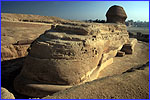
|

|
The Great Sphinx of Giza

The most enigmatic of sculptures, the Sphinx was carved from a
single block of limestone left over in the quarry used to
build the Pyramids. Scholars believe it was sculpted about
4,600 years ago by the pharaoh Khafre, whose Pyramid rises
directly behind it and whose face may be that represented on
the Sphinx.
|
 The Sphinx from the rear, gazing down on Cairo.
The Sphinx from the rear, gazing down on Cairo.
|
Half human, half lion, the Sphinx is 240 feet long and 66 feet
high. Badly eroded, it has undergone numerous restorations
over the millennia, beginning with one conducted about 1400
B.C. by the pharaoh Tuthmosis IV, who dreamt that the Sphinx
asked him to clear the sand around it in return for the crown
of Upper and Lower Egypt. The Sphinx has recently undergone a
major modern restoration.
 The so-called "dream stela" of Tuthmosis IV, which
the pharaoh placed between the Sphinx's paws about
1400 B.C.
The so-called "dream stela" of Tuthmosis IV, which
the pharaoh placed between the Sphinx's paws about
1400 B.C.
|
|
In this 180° image, as you "walk" around the Sphinx from
its left side to its right, watch the sunrise first strike the
top of the Khafre Pyramid in the background, then light up the
Sphinx itself. To get a sense of the sheer size of the
sculpture, keep an eye out, too, for the man standing below
it.
How Big Were They?
|
Cutting Granite with Sand
|
NOVA Raises an Obelisk
Lever an Obelisk
|
Explore Ancient Egypt
|
Mysteries of the Nile
|
Resources
|
Transcript
Medieval Siege
| Pharaoh's Obelisk |
Easter Island |
Roman Bath |
China Bridge |
Site Map
Editor's Picks
|
Previous Sites
|
Join Us/E-mail
|
TV/Web Schedule
About NOVA |
Teachers |
Site Map |
Shop |
Jobs |
Search |
To print
PBS Online |
NOVA Online |
WGBH
©
| Updated November 2000
|
|
|



 The Sphinx from the rear, gazing down on Cairo.
The Sphinx from the rear, gazing down on Cairo.
 The so-called "dream stela" of Tuthmosis IV, which
the pharaoh placed between the Sphinx's paws about
1400 B.C.
The so-called "dream stela" of Tuthmosis IV, which
the pharaoh placed between the Sphinx's paws about
1400 B.C.